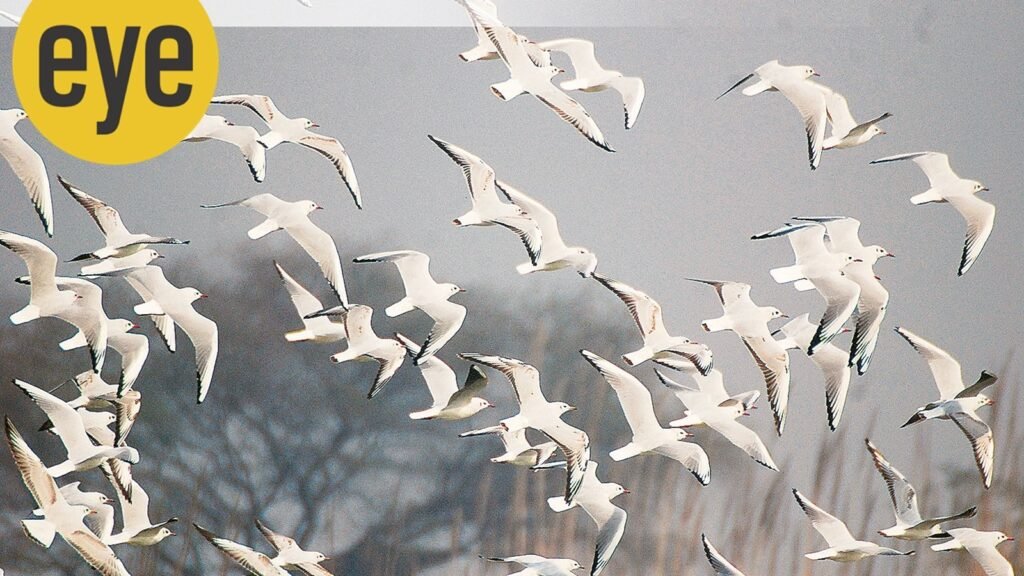When we first shifted to north Delhi, back in 1980, I was happy to know that our house was just about 2 km away from the Yamuna. This was promising: I could get myself an inflatable raft and scull up and down the river, watching the birds that flocked there in peace. Of course, nothing of the sort materialized and the best I could manage was to (with my ex-brother-in-law) hire a paddle boat in which we paddled all the way from Quidsia Ghat to the clanging iron bridge at Salimgarh. But it was cool: from mid-stream (keeping an eye out for sandbanks), Delhi, with its temples and spires, and washer-men thrashing sheets on the riverbank, seemed transported way back into the middle ages. I don’t remember what birds we actually saw, but I do remember that pedalling back upstream to Quidsia Ghat, made us think twice about repeating such an endeavour. Quietly, the river flexed its muscles, its invisible powerful current making it feel like we were pedalling up Mt. Everest.
But yes, there were bird walks we held regularly along the riverbank (back in the late 1980s and early 1990s), from the Dickensian power station at ITO to Nigambodh Ghat. The area around the power-station was littered with cinder, mud, excrement and garbage, yet in the winter of 1988, there were birds a-plenty. Scores of larks of all sorts, playing hide and seek amidst the clouds or circling the skies like small feathered musical boxes, hordes of glistening starlings (with deplorable dietary preferences), three models of shrikes (the long-tailed, the large-grey and the snazzy bay-backed,) drongoes like black blades knifing after insects, turquoise kingfishers flashing past, and dumpy little ringed plovers, so properly turned out in their black scarves. Over the water, there were gulls (black- and brown-headed) snatching up namkeen thrown at them by people crossing the pontoon bridges, and low over the water steely blue swallows patrolled up- and down-wind, snapping up insects. And what’s a river in winter without its ducks – deep diving grey and ginger pochards, squadrons of teals all masked as if for a costume ball, upright chocolate and silver pintails, and beady eyed shovellers floating low, eying you malevolently. But as the years went by the number and variety of birds along this route dropped drastically.
Way upstream, at Palla village where it enters Delhi, the river is still fairly clear, by the time it reaches Okhla around 20 km downstream it is covered with stinking toxic sludge. Yet the birds continued to come, depending on the water level – ducks, waders and even flocks of candy-pink flamingos. A good place to just stand (or sit) and stare at the river is at the Phase 2 section of the Yamuna Biodiversity Park: there will be yellow-bellied warblers trilling amongst the reeds, striated babblers glaring at you, red munias looking like they’ve been shot in the bottom (in winter), and overhead a great Pallas’s gull might wheel and watch the ducks and coots below. Black- and brown-headed gulls gather in their thousands, giving you breath-taking flypasts from time to time. These days, alas, the pollution and fog has put paid to all this! And during the monsoon, the river gets enraged, roaring and rushing over its banks, claiming back its old bed near the Red Fort, and threatening to devour even the homes of those in power who have done nothing to clean it up.
To another river now, far, far, away: the American River that flows for just 45 km from the Sierra Nevada mountain range to join the Sacramento River in California. Decades ago we went rafting down this river one brilliant morning. Duly clad in bright orange life jackets, we coasted down the river, so clear you could see the pebbles on the riverbed. It was silky calm – and getting very hot, so like an idiot I removed my lifejacket and sat on the rim of the inflatable. Promptly the river played its devious card: the inflatable hit a snag (a branch sprawled across, like one of Delhi’s notorious police barricades), the section I was sitting in dipped and I made a professional diver’s upside down entry into the water. The only problem: I can’t swim.
As I spluttered to the surface, I glimpsed two torpedo-like shapes slice into the water: both my sisters are crack swimmers and were by my side in a trice. ‘Pedal! Just keep pedalling!’ one screamed as we were swept downstream at the rate of knots. It wasn’t too bad, because, though we were in the middle of the river, I could still feel the river pebbles whip past with my toes: it was like being on a fast-moving conveyor belt. But we had to get to the shore, and that’s when things became interesting. Suddenly it got deeper, there was no ground beneath my feet, and I went down. I yanked both my sisters down with me, who promptly let me go. Down I went again, now too exhausted to even pedal. Somehow I had managed to keep my mouth shut, but now, alone amidst a welter of silver bubbles, I remember calming down and thinking, ‘okay, well at least there’s no pain, and now let’s see what’s on the other side.’
Picnickers on the shore had seen our plight and two guys leapt in. ‘Okay, so just keep still!’ one told me as he took me into what was I guess a life-saving manoeuvre and towed me out. We mumbled our thanks. My sisters eyed me balefully: ‘you would have drowned us!’ Which was true. Meanwhile the river flowed innocently past.




